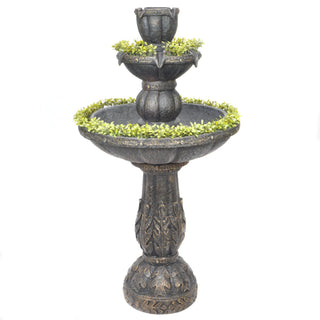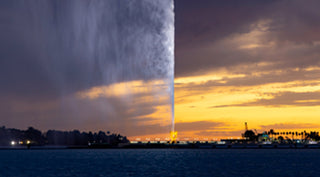Fountains, as we know them today, were nearly forgotten entirely and lost to history. Originally a means to provide fresh water to entire cities via public basins and private springs, the rediscovery of these engineering feats led to an entirely new understanding of these features.
Some of the first fountains are found in ancient Greece where they served an entirely utilitarian purpose. Using aqueducts and bronze piping, water would be brought from outside the city to a centrally located spring for drinking water. The Athenian ruler, Peisistratos, commissioned the main fountain of Athens in the main square or the Agora. His fountain had 9 large spouts meant to provide fresh water to his people. Adorned with masks at the head of the spouts to add decorative flair to the main square, these often resemble animals, such as the head of a lion.
 Ancient fountain location found in Corinth
Ancient fountain location found in Corinth
While most Greek fountains operated using gravity to generate water flow, they also developed the method of siphoning to generate water flow for some of their public fountains. These early fountains were the standard and would not be truly surpassed until the Roman empire began to implement them in their own cities.
The Romans used lead pipes to connect all of their fountains to the vast and complex aqueduct systems of the Roman cities. For instance, the city of Rome is believed to have a water supply fed by 9 aqueducts which was used by 39 grand fountains as well as 591 public basins. All important fountains were also connected to multiple aqueducts in order to guarantee water flow, even in the event of necessary maintenance. Some Romans even had smaller fountains in the courtyards of their homes or villas. Pliny the Younger told of a fountain in a banquet hall that, when guests sat at the marble chairs, would begin to flow and fill a basin which would bring meals to the guests in floating trays.
 Roman Aqueducts
Roman Aqueducts
The original Roman aqueducts that were implemented throughout the empire largely fell into disrepair as the knowledge of how to construct and maintain these engineering projects was forgotten. Some structures remained throughout the ruins of the fallen empire, however, most fountains could only be found in a piece of art or in literature during the Medieval era.
Some survived in monasteries, while there is reference to the presence of fountains in romantic gardens meant for relaxation and courtship. These Medieval fountains would become intertwined with religious and philosophical themes. Common throughout the world was the purity they represented, often being centerpieces in representations of paradise or Eden. As sources of fresh water, the parallel is evident. Others served the same purpose as most sculpture or art for that matter, telling stories of local history or representing grand allegories, much like the Fontana Maggiore. As religious symbols in the Christian world or within the gardens of Islamic Caliphs, fountains served to represent the themes of paradise and purity.
 The Fontana Maggiore
The Fontana Maggiore
As the engineering of fountains began its rediscovery within the islamic world near the end of the Medieval period, grand fountains were constructed within their palaces and gardens using many of the same techniques the Romans had perfected. However, as they came to grips with the forgotten knowledge, they discovered the first water pump. Al-Jazari was commissioned to create a fountain with rising water; he achieved this with the double-acting reciprocating pump.
Soon during the Renaissance, Europe began to rediscover the magic of fountains as well and the original purpose of these installations began to shift. While still acting as a public utility to provide a source of clean drinking water, many fountains commissioned as time went on worked to serve other purposes. As public works or in private collections, fountains all over the world served to represent the intentions of their benefactors. A pious act from a wealthy muslim to provide clean drinking water to a town. A show of influence by the Catholic church to remind followers of their benevolence amidst the growth of protestantism. Or as a show of power and achievement in the case of the high merchants and rulers like the Medici’s.
Sculptures were given life and motion through the cascading water features. The great fountain of Neptune made in honor of and at the behest of the eccentric Cosimo Medici is a fantastic sculpture that came to life with the addition of water spouts enveloping the towering figure of Neptune, made in the image of Cosimo no less.
 The Neptune Fountain
The Neptune Fountain
As previously stated the Catholic church was a common benefactor of fountain construction throughout their sphere of influence. The Baroque era fountains makeup the vast majority of our ideas of what fountains are - largely aesthetic pieces of grand sculpting draped in cascading water. The gardens of Versailles or that of Peterhof Palace represent the unrestricted decadence with which most fountains are constructed under.
 Peterhof Palace
Peterhof Palace
Today, most fountains are entirely for aesthetic purposes, as they do not serve as a public utility. With the advent of water pumps, we can create fantastic streams of water that our predecessors could have never imagined being achieved by man. We have cooling fountains built in tropical regions that provide a cool breeze in the air from a distance, and a refreshing shower for those underneath them. Some are musical and many are built with lighting taken into account, creating fantastic illuminations at night against the sculptures. Some fountains reach heights never before imagined, like King Fahd's fountain, which surges a stream of water nearly 900 feet into the air, and some create spectacles of motion like the ever familiar fountains of Bellagio.
 King Fahd's Fountain
King Fahd's Fountain
At Bernini, we bring elegance and ingenuity to your home, drawing inspiration from the vast history of fountains to generate exquisite experiences. It all starts with strong family ties, here at Bernini. A long heritage of inventing, with five generations of innovators the Yeiser family brings a strong heritage. Initially making strides in the garden industry with innovative hoses, the next step taken was to bring a breath of fresh air to fountains.
 Bernini Florence 4-Tier Fountain
Bernini Florence 4-Tier Fountain
Bringing traditional fountain design forward with innovative technology that opened new ways of using a garden fountain. Without cords leashing them to the nearest power outlet, a new freedom was gained in the garden. Durable materials made them more resilient to weather and gave them a longer lifespan. Further advancements like solar recharging capabilities were used to further extend battery life providing more enjoyment per charge than any fountain before. Our fountains adapted as we learned more from our customer, leading us to bring more creativity to the home and garden than any other before. With customizable capabilities and multiple looks in our multi-use fountains.
Submitted By: Jack Yeiser - Marketing/Sales





